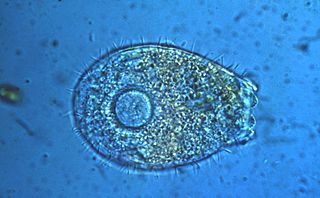| Español | Français | Deutsch |
6.06.2022/29.11.2022
The primordial soup or the prebiotic mud
By the "primordial soup" is meant that "accidental mixture" of chemicals which, under a certain temperature and perhaps exposure to light, caused the formation of the first biological cell.
After the Cassini scientists of the NASA assume that on Titan (moon of Saturn) a primordial soup has originated, one can forget all previous assumptions about the origin of the biological nature.
Wikipedia 2022.05
Heterotrophic theory
A coherent scientific argument was introduced by Soviet biochemist Alexander Oparin in 1924. According to Oparin, in the primitive Earth's surface, carbon, hydrogen, water vapour, and ammonia reacted to form the first organic compounds. Unbeknownst to Oparin, whose writing was circulated only in Russian, an English scientist J. B. S. Haldane independently arrived at a similar conclusion in 1929. It was Haldane who first used the term "soup" to describe the accumulation of organic material and water in the primitive Earth.
When ultra-violet light acts on a mixture of water, carbon dioxide, and ammonia, a vast variety of organic substances are made, including sugars and apparently some of the materials from which proteins are built up. [...] before the origin of life they must have accumulated till the primitive oceans reached the consistency of hot dilute soup.
- J. B. S. Haldane, The Origin of Life
Today the theory is variously known as the heterotrophic theory, heterotrophic origin of life theory, or the Oparin-Haldane hypothesis. Biochemist Robert Shapiro has summarized the basic points of the theory in its "mature form" as follows:[13] According to the heterotrophic theory, organic compounds were synthesized in the primitive Earth under prebiotic conditions. The mixture of such compounds with water under the atmosphere of the primitive Earth is called the prebiotic soup. There, life originated and the first forms of life were able use the organic molecules to survive and reproduce.
1. Early Earth had a chemically reducing atmosphere. 2. This atmosphere, exposed to energy in various forms, produced simple organic compounds ("monomers"). 3. These compounds accumulated in the prebiotic soup, which may have been concentrated at places such as shorelines and oceanic vents. 4. By further transformation, more complex organic polymers – and ultimately life – developed in the soup.
Possible formation on the Earth and Titan (moon of Saturn)
Most scientists assume that the primordial soup on Earth was formed millions, if not billions of years ago. In the last years one had to include also Titan in the circle of the primeval soup, because on Titan there is a multiplicity of organic materials in large quantity.
But this enormously expands the scientific knowledge. Because until recently this was assumed only on the earth.

Wikipedia.EN 2022.05
Life on Titan
Prebiotic conditions and life
Titan is thought to be a prebiotic environment rich in complex organic compounds, but its surface is in a deep freeze at -179 °C (-290.2 °F; 94.1 K) so life as we know it cannot exist on the moon's frigid surface. However, Titan seems to contain a global ocean beneath its ice shell, and within this ocean, conditions are potentially suitable for microbial life.
The Cassini–Huygens mission was not equipped to provide evidence for biosignatures or complex organic compounds; it showed an environment on Titan that is similar, in some ways, to ones hypothesized for the primordial Earth.Scientists surmise that the atmosphere of early Earth was similar in composition to the current atmosphere on Titan, with the important exception of a lack of water vapor on Titan.
Formation of complex molecules
The Miller–Urey experiment and several following experiments have shown that with an atmosphere similar to that of Titan and the addition of UV radiation, complex molecules and polymer substances like tholins can be generated. The reaction starts with dissociation of nitrogen and methane, forming hydrogen cyanide and acetylene. Further reactions have been studied extensively.
It has been reported that when energy was applied to a combination of gases like those in Titan's atmosphere, five nucleotide bases, the building blocks of DNA and RNA, were among the many compounds produced. In addition, amino acids, the building blocks of protein were found. It was the first time nucleotide bases and amino acids had been found in such an experiment without liquid water being present.
On April 3, 2013, NASA reported that complex organic chemicals could arise on Titan based on studies simulating the atmosphere of Titan.
On June 6, 2013, scientists at the IAA-CSIC reported the detection of polycyclic aromatic hydrocarbons (PAH) in the upper atmosphere of Titan.
On July 26, 2017, Cassini scientists positively identified the presence of carbon chain anions in Titan's upper atmosphere which appeared to be involved in the production of large complex organics. These highly reactive molecules were previously known to contribute to building complex organics in the Interstellar Medium, therefore highlighting a possibly universal stepping stone to producing complex organic material.
On July 28, 2017, scientists reported that acrylonitrile, or vinyl cyanide, (C2H3CN), possibly essential for life by being related to cell membrane and vesicle structure formation, had been found on Titan.
In October 2018, researchers reported low-temperature chemical pathways from simple organic compounds to complex polycyclic aromatic hydrocarbon (PAH) chemicals. Such chemical pathways may help explain the presence of PAHs in the low-temperature atmosphere of Titan, and may be significant pathways, in terms of the PAH world hypothesis, in producing precursors to biochemicals related to life as we know it.
Possible subsurface habitats
Laboratory simulations have led to the suggestion that enough organic material exists on Titan to start a chemical evolution analogous to what is thought to have started life on Earth. The analogy assumes the presence of liquid water for longer periods than is currently observable; several hypotheses postulate that liquid water from an impact could be preserved under a frozen isolation layer. It has also been hypothesized that liquid-ammonia oceans could exist deep below the surface.Another model suggests an ammonia–water solution as much as 200 kilometers (120 mi) deep beneath a water-ice crust with conditions that, although extreme by terrestrial standards, are such that life could survive. Heat transfer between the interior and upper layers would be critical in sustaining any subsurface oceanic life. Detection of microbial life on Titan would depend on its biogenic effects, with the atmospheric methane and nitrogen examined.
Other planets in other solar systems
If already in our solar system very probably two planets could have produced the primeval soup, so one can assume that in almost all other solar systems the primeval soup has also originated. So one can also assume that on many other planets intelligent living beings live.
The possible temperature for the creation of the Primordial soup
It is a fact that, in the beginning, all celestial bodies in the solar system were liquid, glowing balls of fire. Whether this was a Big Bang or a gas cloud is irrelevant and is not discussed here. The Earth and other celestial bodies were glowing fireballs of liquid magma when they formed.
But if that were the case, surely TITAN could not have become an ice planet from one second to the next.
Therefore, we must first discuss the heat periods, or the sequence of thermal conditions in the solar system. I assume that our Sun showed much more activity in its original state 4.5 billion years ago and therefore radiated more thermal energy. Also, smaller bodies cool faster than larger ones.
The possible course of temperature in our solar system
I. Creation and primordial state of the solar system
In their original state, all planets and moons were glowing spheres of magma. On this I absolutely agree with most astrophysicists. But what happened after that?
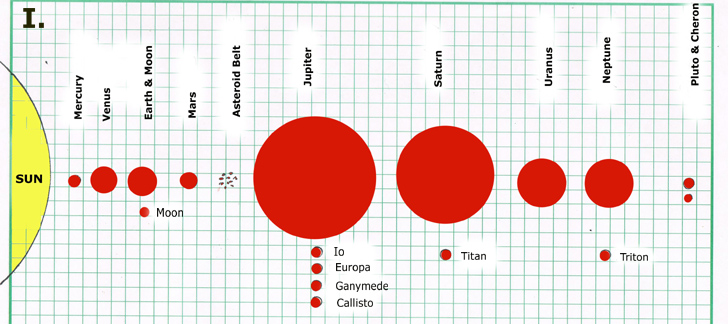
II. First cooling period after about 1 to 2 billion years
In the hinterland of the solar system Pluto and Charon probably had the right temperature for hydrocarbons and thus also for the self-creation of the prebiotic soup.
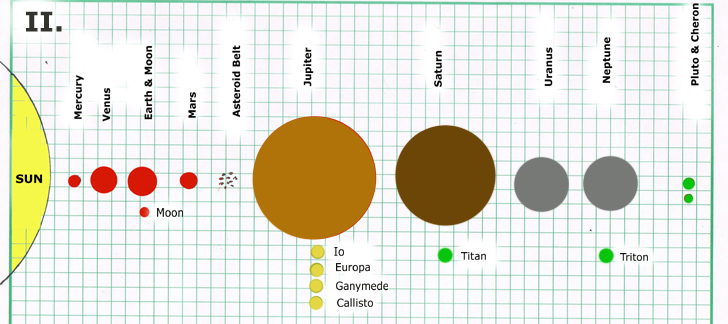
III. 2nd cooling after about 2 to 3 billion years
The central field of the solar system was probably just the right temperature for us hydrocarbon creatures. While Venus and Earth were still too hot.
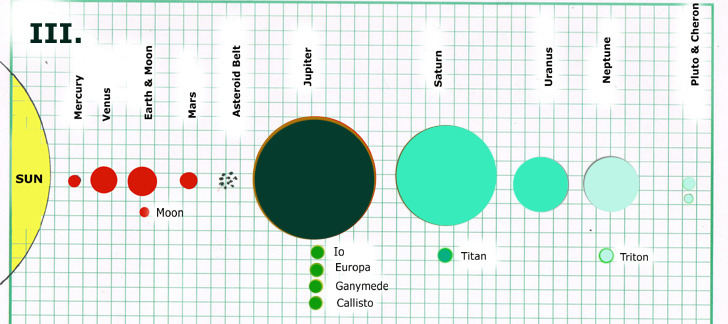
IV. Further cooling and current state after 3 to 4.5 billion years
Venus is still too hot. Earth at the right temperature and all other heavenly bodies too cold.
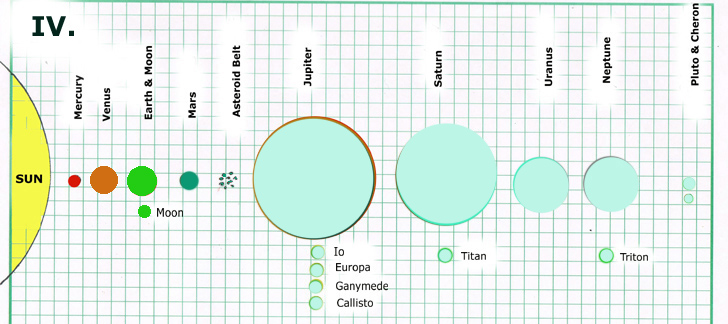
This inevitably leads to the objective question, "why" shouldn't the "primordial soup" have developed earlier in the hinterland of the solar system? That is, the mixture that should have made possible the first unicellular organism and thus initiated the Cambrian period.
